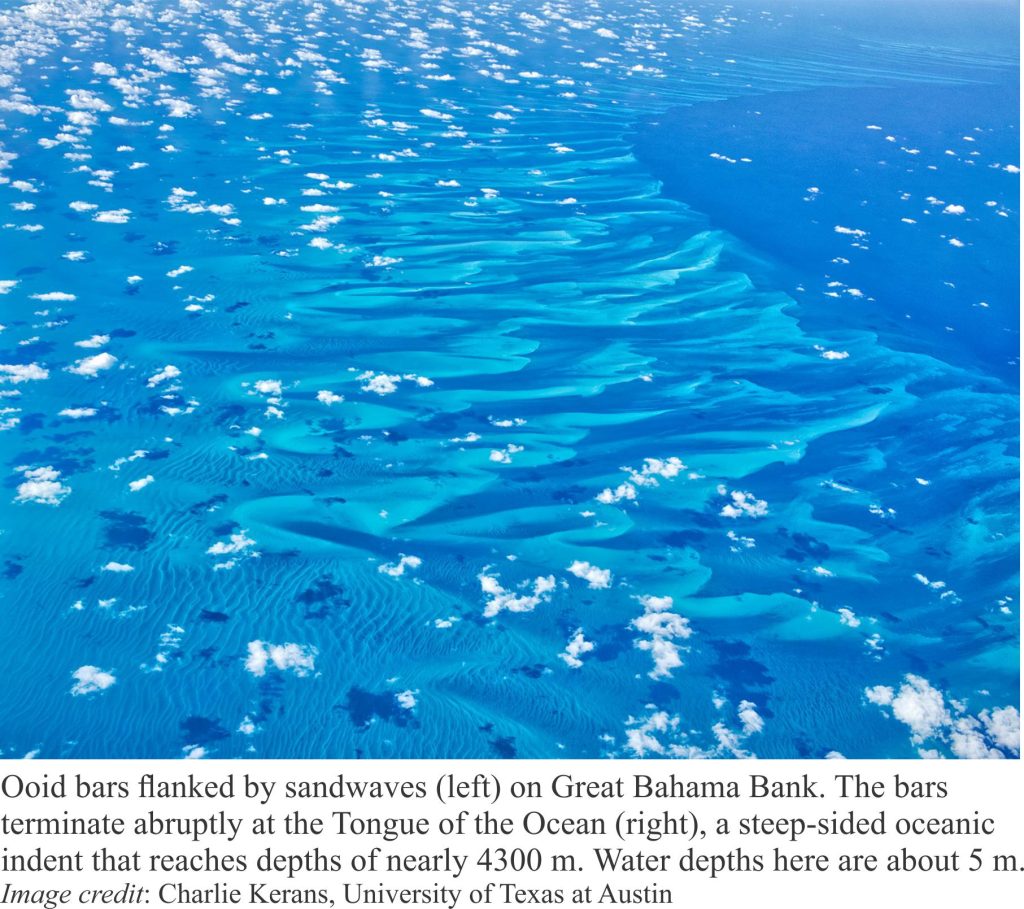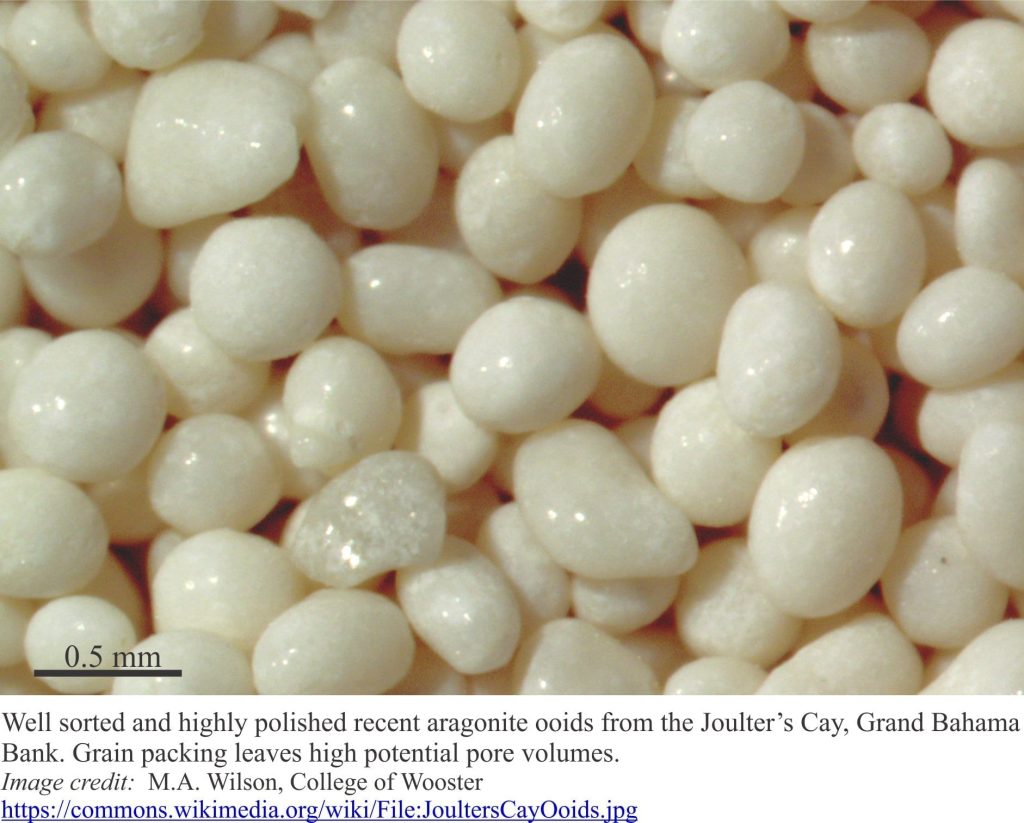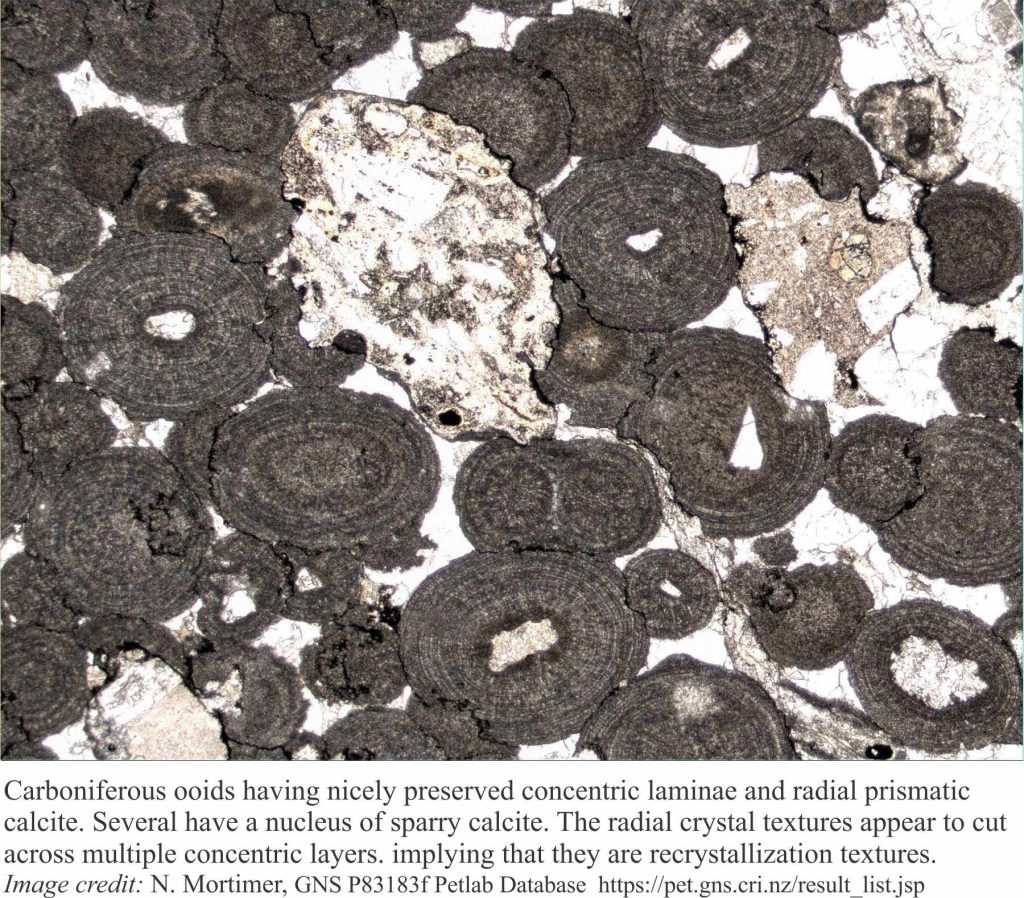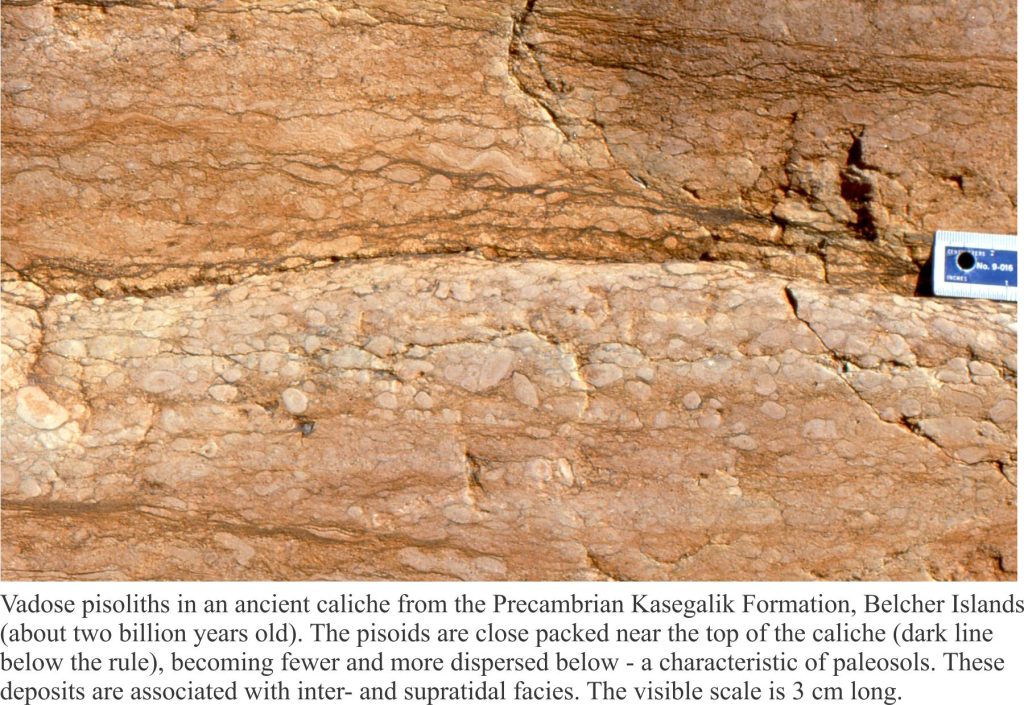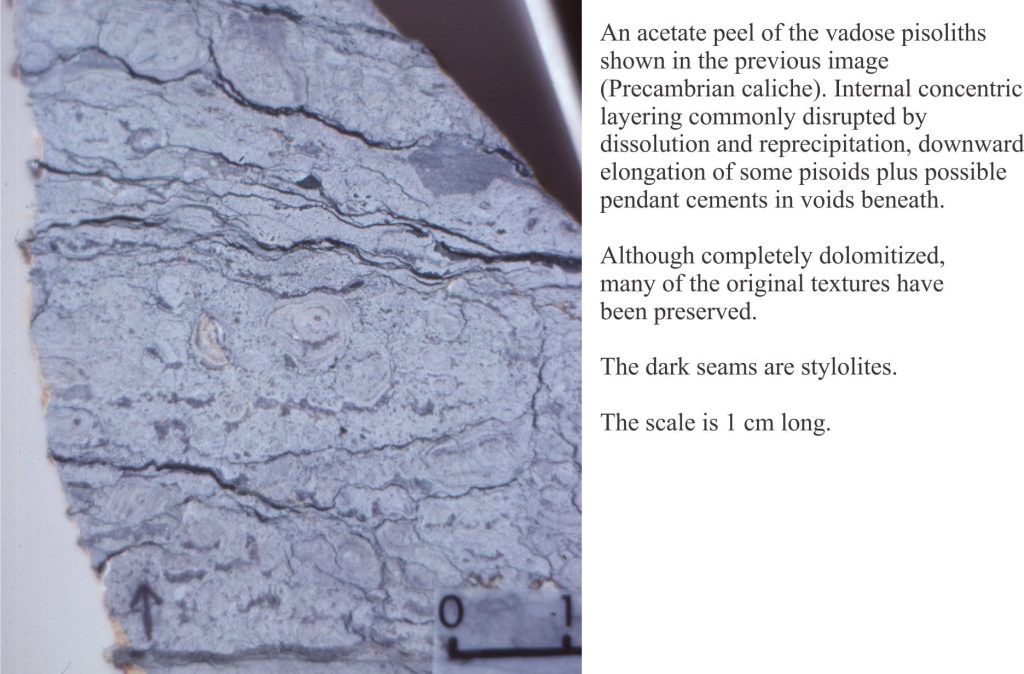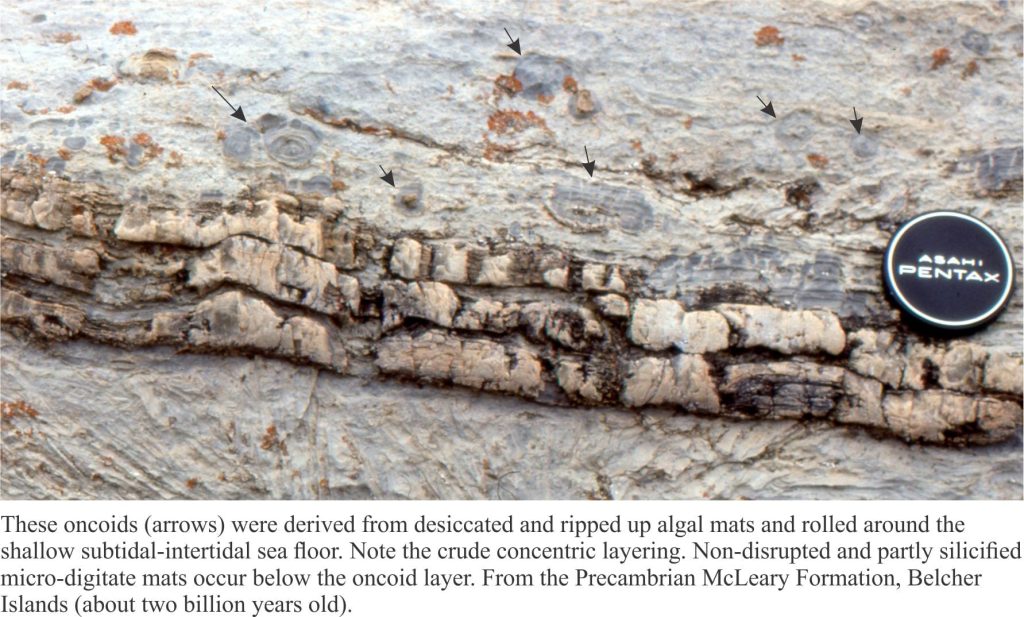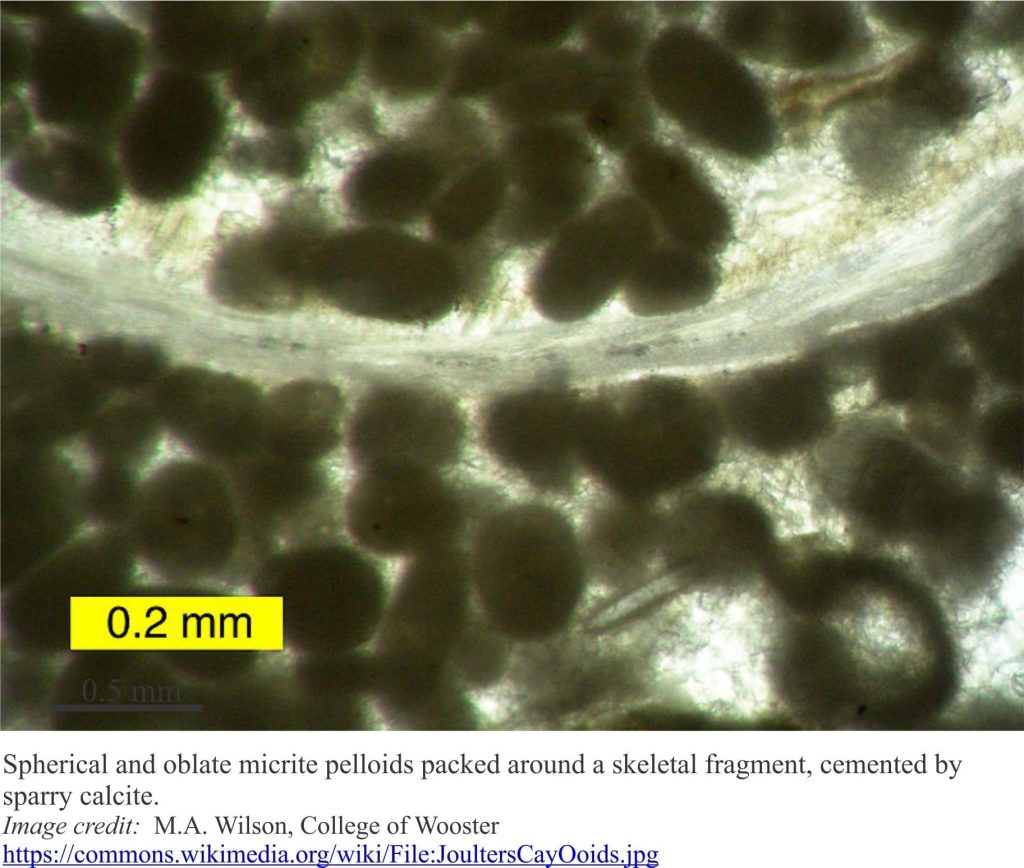A post in the How to… series on carbonate mineralogy – non-skeletal components
Ooids, pisoids, oncoids and pelloids comprise the most common non-skeletal component of limestones. The first three are characterized by enveloping laminations that range from perfectly concentric spheres to strongly asymmetric grains. They are all products of calcite and aragonite precipitation at the sediment-water interface or within the vadose zone of shallow burial. Although non-skeletal, there is mounting evidence that their formation is influenced, even promoted by biological activity, particularly by bacteria, fungii and algae.
Ooids
Having the opportunity to study modern ooids must be a real treat; a fortuitous circumstance that puts the sedimentologist fair and square in the balmy Bahamas or Trucial Coast (Arabian Gulf). Oh well, I got to spend field seasons in the Canadian Arctic.
Modern sea-going ooids presently form in tropical settings that promote precipitation of aragonite and high-Mg calcite. Ooids are spherical to subspherical grains, characterized by concentrically layered, micron-sized calcite or aragonite crystals. Bahamian ooids are generally 0.5 mm diameter and less. Their cortex consists of micron-sized aragonite crystals that are organized roughly tangential to grain surfaces. The cortex usually envelops a nucleus of skeletal debris, foraminifera or fecal pellets. Variations on this theme are found in some saline lakes where the cortex is a radial array of acicular microcrystals (calcite and aragonite) around a nucleus (e.g. Great Salt Lake, Utah). Ooids are also documented from Precambrian iron formations and Phanerozoic iron-rich deposits where the cortex consists of iron oxides.
Swaths of ooid sediment blanket the Great Bahama Bank beneath clear waters no deeper than 5-10 m. Along the Trucial Coast they accumulate in shallow high energy tidal deltas associated with barrier islands and lagoons. Ooids are subjected to waves and tidal currents, that polish, and sort them according to grain size. Bedforms abound, ranging from large sand-waves (subaqueous dunes) to ripples. Ooids may also be mixed with skeletal debris and pelloids (limestones with ooid frameworks are called oolites). The propensity for ooids to form in shallow, high energy depositional settings makes them excellent paleoenvironmental indicators.
Ancient ooids also display concentrically layered cortices but invariably they are composed of radially fibrous or acicular calcite. In thin section and under polarized light the radial fabric gives rise to an extinction cross centered on the ooid nucleus, that rotates with the microscope stage. This begs the question ‘were the ooids originally calcite (high or low Mg) or aragonite?’. Those that were originally calcite may preserve in fine detail the radial pattern and concentric layering. In contrast, calcite that has replaced aragonite tends to lose some (but not all) of this textural detail. The question is complicated further if the calcite in either case shows any degree of recrystallization – this usually results in larger crystals that destroy original textures and fabrics. Dolomitization tends to exacerbate this problem.
The origin of ooids has been a topic of discussion for at least the last two centuries: explanations ranging from fish eggs to mechanisms invoking snowball accretion of aragonite, from the purely physico-chemical (with no biological interference) to purely biological. Take a look at the excellent summary of past and current ideas in a review by Harris, Diaz and Eberli (2019). What is known is that, whether aragonitic or calcitic, they are the product of direct precipitation from seawater or saline lake water. Research over the last few decades has also shown that biological mediation by microbes is also a critical factor in the formation of ooids.
The association of organic matter, algal filaments, bacteria and fungii enmeshed with aragonite crystals in ooid cortices has been known since the 1950s. These early discoveries promoted the idea that the organic matter and microorganisms changed the chemical microenvironment at sites of crystal growth (pH and the activity of Ca2+ and CO3 2-). While it is likely these biochemical processes do operate, it is now understood that microorganisms play a more complicated role in carbonate biomineralization by creating an organic template that fixes Ca2+ and CO3 2- ions and provides sites for crystal nucleation.
Pisoliths and pisolites
Pisoliths (or pisoids) bear a superficial resemblance to ooids, but are larger (>2 mm) and concentric layering is more irregular. A classic case of misinterpreted pisoliths lies in the Permian Capitan Reef complex (Texas). Originally interpreted as sedimentary and of algal origin (concentric layering of algal laminates), R. Dunham (1969) concluded that they had formed as concretionary structures within the rock column, specifically the vadose zone of subaerially exposed carbonate deposits. The Capitan Reef structures grew by progressive in-situ calcite and aragonite precipitation (the cemented rock is a pisolite). The vadose zone occurs between the land surface and the watertable (sometimes called the unsaturated zone). Sediment within the vadose zone is wetted when the watertable rises, and by surface water infiltration during precipitation events. Thus, carbonate precipitation is a periodic process associated with alternating sediment wetting and drying. Pisoliths may grow competitively producing fitted contacts. Downard elongation of laminae, another characteristic feature, is probably a response to the gravity-driven seepage. There may also be periods of carbonate leaching that remove segments of the pisoliths; subsequent regrowth will result in discordant sets of carbonate layers.
Vadose zone pisoliths are excellent indicators of subaerial exposure and ancient soil-forming conditions, particularly carbonate paleosols or caliches.
Oncoids and oncolites
Oncoids are rounded, spherical to oblate, laminar growths of algae around a nucleus (shells, mud intraclasts, broken lumps of algal crust). Their dimensions are measured in centimetres. The algae usually associated with oncoids are the cyanobacteria (of stromatolite fame). They grow at the sediment surface in supratidal (including sabkhas), intertidal and shallow subtidal environments that are agitated by currents and waves, and perhaps frequented by storm surges. Oncoid laminae grow asymmetrically while the oncoid is at rest, and discordantly when growth has been interrupted by clast jostling and rolling.
Pelloids
The term pelloid refers to any grain that is an aggregate of micro- to cryptocrystalline carbonate. Most pelloids are spheroidal and sand sized; there is little or no internal structure. If they are known to be fecal then they are called pellets. Otherwise, the term pelloid should be used.
Pellets are very common in lower energy settings like lagoons; walk over any tidal flat strewn with gastropods and there will be countless mounds and ribbons of fecal pellets. Fecal pellets contain high proportions of organic matter that break down to organic acids during burial. Their softness also means that grains are susceptible to compaction. Closely packed pellets will tend to merge into a single mass to the point where individual grains become indistinguishable; the end product may be a micrite that is indistinguishable from non-pelloidal deposits.
Like other micrites, pelloidal limestones are susceptible to recrystallization. Note that the term pelloid is also used for skeletal fragments that have been micritised by endolithic algae and fungi.
links to other posts in this series
Bivalve shell morphology for sedimentologists
Gastropod shell morphology for sedimentologists
Cephalopod morphology for sedimentologists
Mineralogy of carbonates; skeletal grains
Mineralogy of carbonates; lime mud
Mineralogy of carbonates; classification
